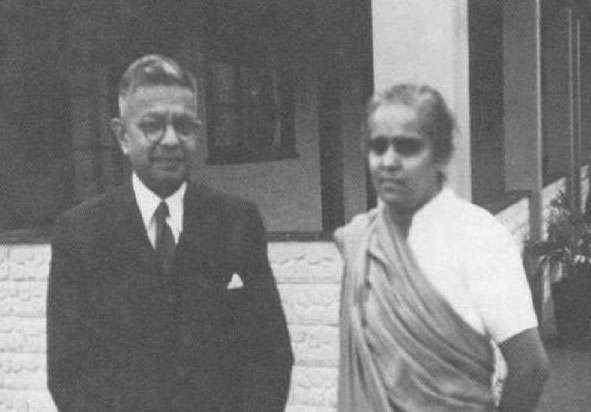

The Gandhi That India Forgot: Mahatma's son Manilal's rich legacy in South Africa- by Kirti Pandey Manilal Gandhi lived a life of austerity and strived to be a worthy inheritor of his father's legacy. He was also jailed for 10 months participating in the Dandi March. He remained overshadowed by the Mahatma. Manilal Gandhi and Sushila Gandhi at Phoenix Settlement in South Africa Manilal Mohandas Gandhi - one of the sons of the Mahatma who had some big shoes to fill, and did so by operating within the sometimes tough constraints set by his father. On 2nd October every year, we observe the birth anniversary of Mahatma Gandhi. We know little about the strong sapling that strived to grow under that impressive Banyan tree, though. Manilal Gandhi was the second son of Mahatma Gandhi. About him, former South African President Nelson Mandela had once recalled that Manilal’s “gentle demeanour seemed the personification of non-violence”. Birth in India, but Karma Bhoomi South Africa:Manilal Gandhi was born on 28 October 1892 in Rajkot, India, the second son of Kasturba and Mohandas Gandhi. He had three brothers, with whom he first came to South Africa in early 1897 when Gandhi's family joined him in Durban. Mahatma Gandhiji did not believe in formal education, therefore Manilal's schooling took place at home. Phoenix Settlement (founded in 1904) and Tolstoy Farm (founded in 1910) were important training centres and Manilal was regarded as one of the first experimental students. And what did the students learn here? The focus was on manual labour, character building and some formal subjects. From an early age, Manilal learnt to work in the printing press at Phoenix. Back and forth between South Africa and India:Gandhiji had, by then become a full-fledged newly qualified lawyer accepted a year-long contract with an Indian-owned firm in South Africa. After his father decided to stay longer in South Africa, the family joined him there in 1897. When Gandhi in 1901 decided to return to India, so did the family. Gandhi returned to South Africa the next year (1902), and subsequently, so did the family. In June 1906, the family shifted to a communal farm named Phoenix. It was not just the Indians that Manilal felt for or fought for. Manilal identified with all non-whites who were struggling to improve their lives and secure their rights to the land of their ancestors and acquire full citizenship. In 1910 Manilal, then just seventeen years old, joined the satyagraha struggle and between 1910 and 1913 he served four prison sentences. Uma Dhupelia-Mesthrie, Manilal’s granddaughter, in her book ‘Gandhi’s Prisoner? The Life of Gandhi’s Son Manilal’ writes, “Phoenix and Manilal’s life would become intertwined in ways he could hardly imagine”. Therein, he undertook laborious tasks, worked on the land, spent time in the press assisting in the publication process, and tended to the elderly and sick. Manilal's life of a Satyagrahi:Uma writes that Manilal was arrested on 14 January 1910 for illegally hawking on the streets of Johannesburg. He was given a choice between 10-day imprisonment and a 30-shilling fine, Manilal chose the former. In prison, he continued his Satyagraha, suffered solitary confinement as a punishment, but acquired the rights of political prisoners. These actions seemed natural from Gandhi’s son. While in prison in Pietermaritzburg and later Durban in 1913 he led a hunger strike for better prison conditions. But India was never too far away. Between 1914 and 1917 Manilal helped found Gandhi's ashram in Ahmedabad and began learning khadi production. In 1917 Gandhi sent Manilal back to South Africa to help in the production of Indian Opinion (founded in 1903) especially the Gujarati section. He remained its longest-serving editor and did so for zero remuneration as his father MK Gandhi insisted that everything was for public service, not personal enrichment. In 1927 he married Sushila Mashruwala who became his partner in the printing press. They had three children, Sita, Arun and Ela. In 1929 Manilal who was on a short trip to India joined the nationalist struggle. Manilal was also one of the 78 people who accompanied Gandhi on his famous 1930 Dandi March and also served a 10-month prison term for his involvement in the march to Dharasana Salt-works. Back in South Africa in 1956, he joined the passive resistance struggle and went to jail for 23 days. In 1946, he participated in the campaign of the South Africa and NIC to demonstrate against the Asiatic Land Tenure ("Ghetto") Act. In 1948, he led marchers across the Transvaal border in 1948 and in 1951 he began an individual campaign to protest against petty apartheid laws such as bench apartheid, separate libraries and post offices. In 1952 he took part in the defiance campaign went to jail at the age of 61. When he died in 1956 he had no money to his name.He saw non-violence and satyagraha as the way to secure change. He was fearless and was prepared to die for a cause if need be. He belongs to both India's and South Africa's story of national liberation. He had become a notable human rights activist. On his death, India’s then-President Rajendra Prasad wrote, "Indians in South Africa have lost a prominent leader... The whole Indian community...needed the help, cooperation and guidance of men of his type". After his death, his wife continued to publish the newspaper until 1961. Courtesy: TimesNowNews.com, dt. 30 September, 2020 |